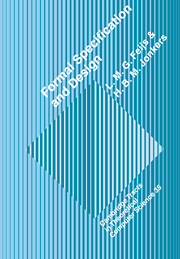Book contents
- Frontmatter
- Contents
- List of figures
- List of tables
- Preface
- I Algebraic specification
- II State-based specification
- 5 From algebras to states
- 6 Setting up state-based specifications
- 7 Structuring state-based specifications
- 8 Implementing state-based specifications
- III Advanced techniques
- Bibliography
- A Syntax
- B Standard library
- Index
6 - Setting up state-based specifications
Published online by Cambridge University Press: 02 November 2009
- Frontmatter
- Contents
- List of figures
- List of tables
- Preface
- I Algebraic specification
- II State-based specification
- 5 From algebras to states
- 6 Setting up state-based specifications
- 7 Structuring state-based specifications
- 8 Implementing state-based specifications
- III Advanced techniques
- Bibliography
- A Syntax
- B Standard library
- Index
Summary
Kinds of axioms
In Chapter 2 a number of techniques for setting up algebraic specifications were given. Now we want to do the same for state-based specifications. Recall that a state-based specification serves to describe a system whose model is a ‘class’. A class is a kind of state-machine where each state has an algebra associated with it. Because each such algebra can be viewed as a static world model, classes with their state transitions can be viewed to model dynamic systems. Special language constructs to specify these systems were introduced, such as procedures and the operators of dynamic logic. It is typical for these language constructs that they leave the sort of states implicit.
Therefore the techniques of Chapter 2 are mostly useful for describing the static aspects of states, whereas we need complementary guidelines for dealing with the dynamic aspects of a system. This is the main topic of this chapter. Key notions are that of precondition, postcondition and invariant.
In practice it turns out that there are certain patterns that occur quite often in state-based specifications, providing methodological guidelines for systematically setting up state-based specifications. In this chapter we shall do this, focusing on the axioms, and we adopt a classification distinguishing four distinct roles an axiom can play. These roles correspond to typical syntactic patterns. We shall refer to these by saying that there are four kinds of axioms:
properties of all states;
invariance properties;
properties of the initial state;
properties of state transitions including pre- and postcondition axioms and termination axioms.
- Type
- Chapter
- Information
- Formal Specification and Design , pp. 143 - 170Publisher: Cambridge University PressPrint publication year: 1992



